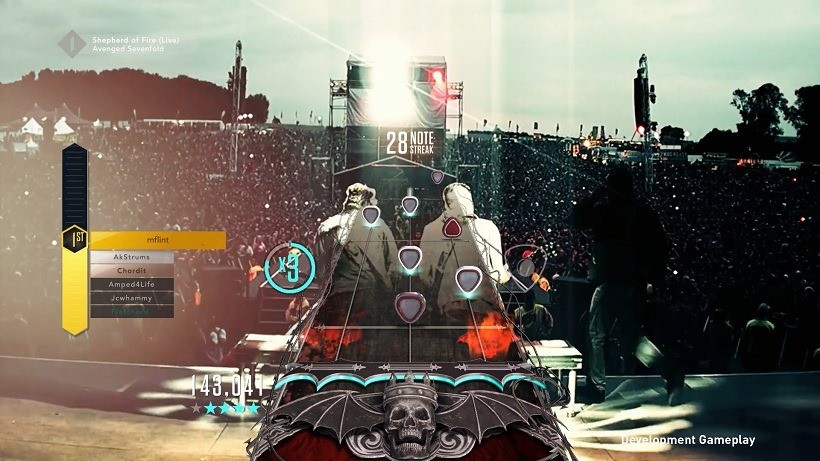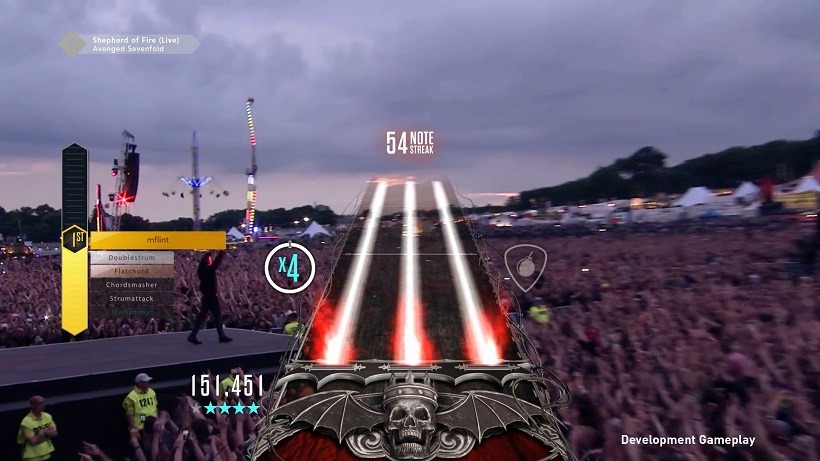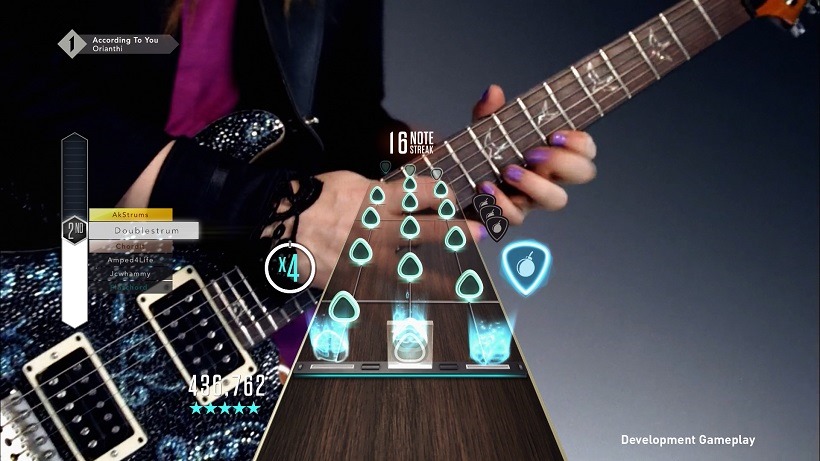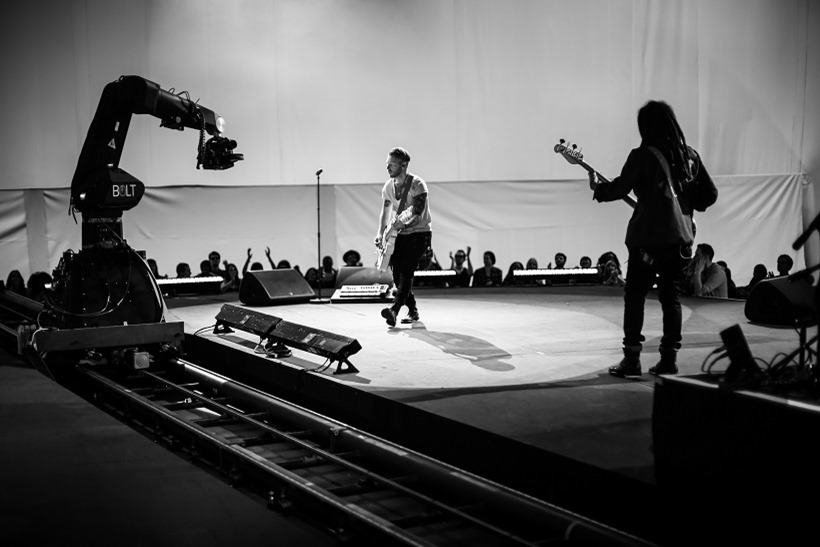
Last week, I was fortunate enough to be flown to a bustling London to not only play Guitar Hero Live, but also to take a tour of the studio developing the title, FreeStyleGames. Finally, I could see what went on behind the closed doors of an office dedicated to the marriage of music and gaming via a neat guitar peripheral!
First things first. Yes, I did get some hands on time with the game, but no, this article will not be detailing that experience. I’ve already shared my impressions on Guitar Hero Live based on my time with it at Gamescom. My opinion has not changed – I am still stupidly excited to get my hands on my own guitar and the title itself when it launches next month, on October the 23rd.
What I would really like to talk about rather, is my time spent with the FreeStyleGames team. It turns out that London wasn’t the top secret location of their HQ. I got ushered onto a train instead, one which took me out of the bustling city, through a blur of grey and green, and into the quaint city of Leamington Spa. Once at the studio, Jamie Jackson, the Creative Director and co-head FreeStyleGames, welcomed us in. He, along with some of his colleagues, launched into the history of Guitar Hero Live, and the amount of effort it took to bring the game to life.

One of the most notable changes to the franchise, other than the fact that the new branding lacks fire, barbed wire, and dragons, is the new guitar peripheral. In case you’ve missed it, the new controller has scrapped the traditional five coloured buttons in favour of a new six button layout.
This wasn’t a change that just happened by chance. Even though there are tons of videos of people playing previous Guitar Hero titles on expert without breaking a sweat on Youtube for example, they are not an accurate representation of the entire player base. Most people, believe it or not, never progressed past medium – a difficulty that only made use of three of the original guitar’s five buttons.
Based on this information, the new controller was designed to accommodate not only those players that weren’t born with ridiculously long pinkies, but also in such a way that it would make the gameplay experience entirely fresh and challenging for returning veterans. The result is amazing to be honest. Being one of those players that could get by on expert in previous titles, I’m happy to say that I agree with this design change – Guitar Hero feels entirely fresh once more and honestly, more challenging than ever!

Another notable change to the franchise is, obviously, the whole ‘live’ feel. The camera has been flipped around, giving players a first-person perspective of playing a live show, instead of seeing themselves play it as digital avatars from the audience’s perspective. Take a look…
When I first saw the above video, it honestly meant very little to me, at least until I got to play the game myself. There is something special about not only hearing the crowd adore you, but also seeing them react to the way you are playing. Yes, if you suck, they will let you know. The same goes for the opposite though, which is incentive enough to play the song as best as you can.
The fact that the crowd are represented by real people makes a world of difference too, believe it or not. Putting this live footage together, according to Jamie, was not a simple matter of strapping a camera to a guitarist’s head and taking it from there; though the team did try to do just that. Two head cameras were used in early development stages, but they were impractical, heavy pieces of gear that were difficult to work with. That, and that they were worn by humans meant that everything being filmed could never be re-recorded with 100% accuracy.

As a result, robotic rigs were considered. The first, known as the Talos, turned out to be too cumbersome. The second, a cinebot called the Bolt, was lighter, faster, and far more flexible. Most of all, it could be programmed in such a way that what it recorded looked and felt “more human”. The footage it grabbed was used in conjunction with video grabbed by another cameraman. The results speak for themselves really – playing in front of the audience feels damn authentic!
It’s also worth keeping in mind that not just one stage was made for Guitar Hero Live – there are many. This is possibly where I was the most jealous of the FreeStyleGames team. As part of their research for the game, some of them travelled around the world, attending as many music festivals as they could. This was done obviously so they could put together the most authentic game possible, as well as design some truly legit looking stages.


On top of all this, they had to put together fictional bands in the game that really looked the part. Jamie challenged us to come up with band name that doesn’t already exist. That was easy! I went with ‘The Porra Cabbages’, but then he added that the band name should actually sound good. Dang, that is tough!
Creating multiple bands was more than coming up with names too. Finding actual people to fill the roles, and do it well, was another challenge in itself. All of the actors needed to gel together, like a real band would. Seeing them on stage in-game, I think that FreeStyleGames placed people just right.

If anything, I can honestly say that I have a much firmer appreciation for Guitar Hero Live now. I’ve had a glimpse of the all the hard work that was put into it, which I could never hope to fully encapsulate here. Seeing what went on behind the scenes, as well as seeing the office itself packed with around 130-140 staff members, was a real eye opener.
I would also just like to point out that almost every single work station I visited; whether it was in the audio area, the area involved with backend server maintenance for Guitar Hero TV, the area responsible for the actual coding of the game, and everything inbetween – each had a guitar controller nearby. Every staff member is playing the game it seems, which is expected to be honest, but it was just something I took note of and appreciated.

Another thing that I feel needs to be mentioned too, is that the price point of Guitar Hero Live matches that of the last title which came out 5 years ago. Granted, I think it may be a different case for us here in South Africa (it may be more expensive than it was back then), but it’s quite something to see how much effort went into making the game, and yet, the price remains quite reasonable and affordable at around R1599 for the bundle. Sadly, old peripherals will not work. Trust me though, after playing with the new guitar, you will never look back.
I really do believe that both returning fans and newcomers alike will be happy with what they see in Guitar Hero Live. A monumentous effort has been put into bringing this beloved franchise out of retirement, and with a bang!
Last Updated: January 4, 2017





















Stosta
September 29, 2015 at 07:12
Looking forward to drunken nights swearing at my friends with this one!
Graeme Selvan
September 29, 2015 at 08:56
Great article!!!